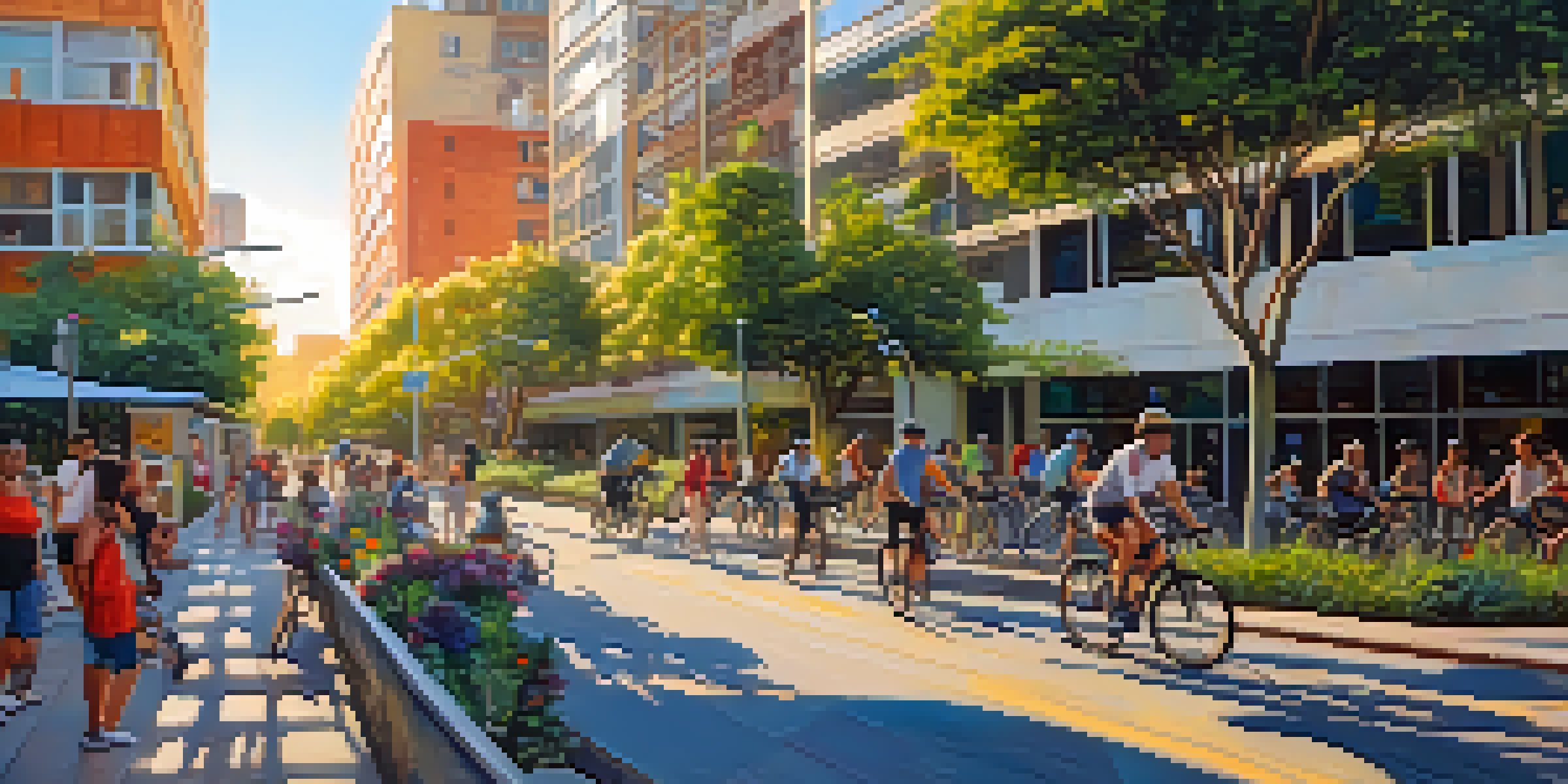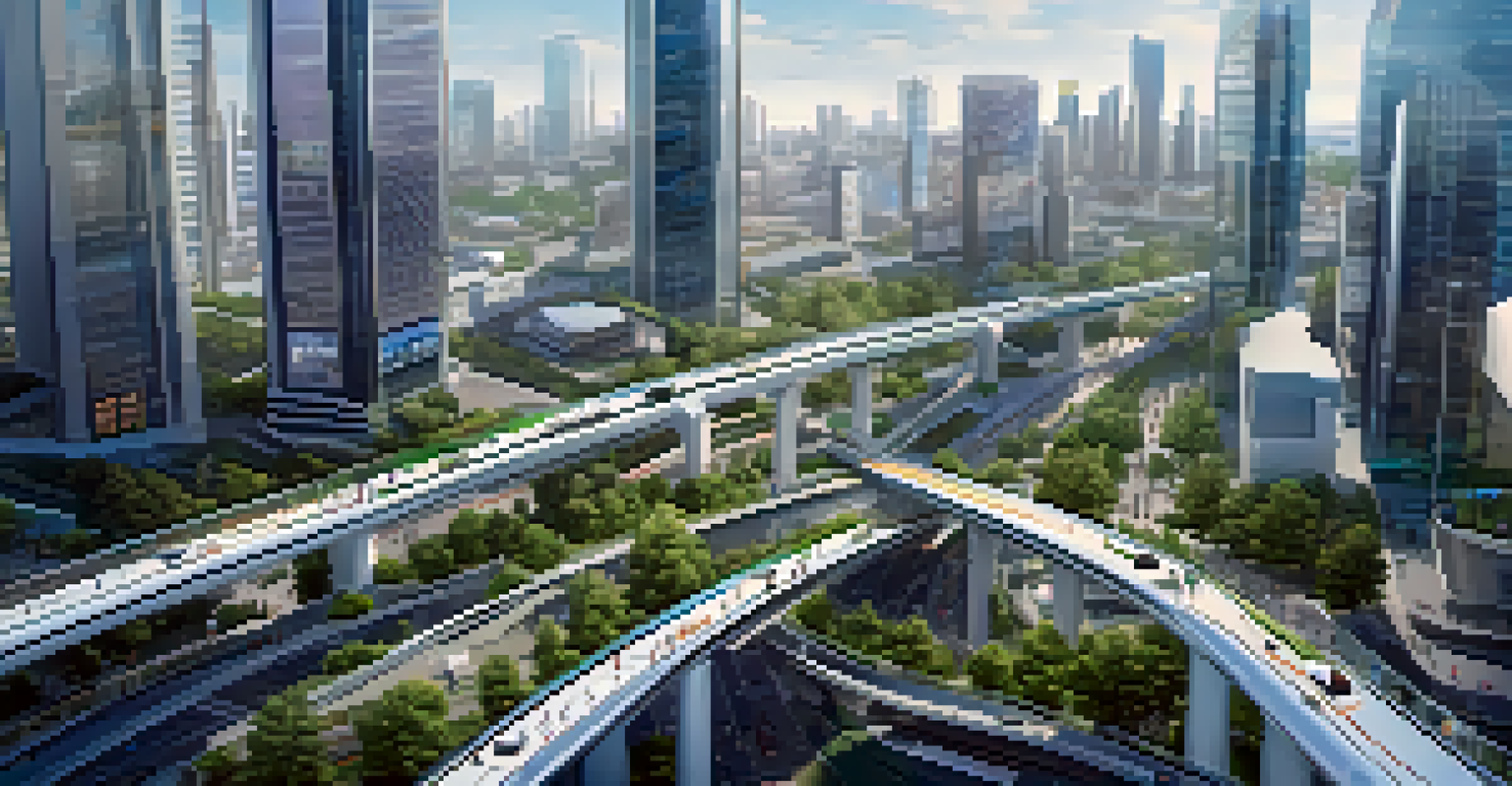The Future of Transportation: Integrating Alternatives in Cities

Understanding the Need for Alternative Transportation
As urban populations continue to grow, the pressure on traditional transportation systems increases. Cities are grappling with traffic congestion, pollution, and a lack of accessibility. This scenario calls for a reevaluation of how we move around urban areas, pushing for innovative alternatives that can ease these burdens.
The future of transportation is not just about getting from point A to point B; it's about creating a more sustainable and enjoyable way to move through our cities.
Alternative transportation options not only aim to reduce congestion but also improve the quality of life for residents. By integrating solutions like biking, walking, and public transport, cities can foster healthier environments. Imagine a city where vibrant bike lanes and pedestrian-friendly streets are the norm, encouraging people to choose greener modes of travel.
Moreover, these alternatives can significantly reduce our carbon footprint. With climate change being a pressing issue, shifting transportation habits is a crucial step toward sustainability. Cities that embrace this change can lead the way in environmental stewardship while enhancing the urban experience.
The Rise of Electric and Autonomous Vehicles
Electric vehicles (EVs) are becoming a go-to solution for reducing emissions from traditional combustion engines. With advancements in battery technology and charging infrastructure, cities are slowly adapting to accommodate EVs. This shift not only supports cleaner air but also encourages manufacturers to innovate further.

Autonomous vehicles (AVs) are another exciting development on the horizon. Picture self-driving cars navigating the streets, reducing the need for parking spaces, and optimizing traffic flow. While this technology is still in its infancy, it promises to revolutionize how we think about personal and public transportation.
Embracing Alternative Transport
Cities must adopt innovative transportation methods to reduce congestion and pollution while enhancing residents' quality of life.
However, integrating these vehicles into existing urban frameworks will require careful planning. Cities will need to create policies that ensure safety, accessibility, and efficiency. It's not just about the vehicles themselves but also about how they coexist with pedestrians, cyclists, and public transport systems.
Enhancing Public Transportation Systems
Public transportation forms the backbone of urban mobility, and enhancing these systems is vital for a sustainable future. By investing in reliable and efficient transit options, cities can encourage more residents to leave their cars at home. Imagine a well-connected network of buses, trams, and subways that run frequently and on time.
Urban planning must prioritize people over cars, creating spaces that foster community and reduce reliance on personal vehicles.
Technology plays a significant role in modernizing public transport. Real-time tracking apps allow commuters to plan their journeys more effectively, while contactless payment systems streamline the boarding process. These innovations can make public transport not only more user-friendly but also a preferred choice for many.
Furthermore, integrating public transport with other alternatives like bike-sharing and walking paths can create seamless transitions for commuters. This holistic approach encourages a multi-modal transportation system that meets the needs of all users while reducing reliance on personal vehicles.
Promoting Active Transportation: Biking and Walking
Active transportation, which includes walking and biking, is essential for promoting healthier lifestyles and reducing pollution. Cities that prioritize safe and accessible infrastructure for cyclists and pedestrians can foster a culture of active commuting. The benefits extend beyond individual health; they contribute to a cleaner environment and less traffic congestion.
Creating dedicated bike lanes and pedestrian-friendly zones encourages more residents to opt for these alternatives. Imagine bustling streets lined with bike racks and people walking leisurely, enhancing community interaction. These changes can transform the urban landscape into a vibrant and inviting space.
Advancements in EVs and AVs
The rise of electric and autonomous vehicles offers promising solutions for cleaner urban mobility, but requires careful integration into existing systems.
Moreover, cities can support active transportation through education and outreach. By promoting the benefits of walking and biking, municipalities can inspire residents to make healthier choices. This collaborative effort can lead to a significant shift in transportation habits and overall community well-being.
Smart City Technology: The Future of Urban Mobility
The integration of smart technology is transforming urban transportation systems. Cities are leveraging data analytics to optimize traffic flow and reduce congestion. Imagine traffic lights that adapt in real-time based on vehicle and pedestrian movement, creating a smoother experience for everyone.
Smart city technology also enhances public transport by providing real-time updates and improving routes. Mobile apps can help commuters track their journeys, making public transport a more attractive option. This data-driven approach not only benefits the users but also helps city planners make informed decisions.
However, the implementation of smart technology must be accompanied by considerations for privacy and inclusivity. Ensuring that all residents can benefit from these advancements is essential for creating equitable urban environments. A truly smart city is one that serves everyone, regardless of their socioeconomic status.
Urban Planning: Designing for Future Mobility
Thoughtful urban planning is crucial for integrating alternative transportation options. Planners must consider how land use, zoning, and infrastructure impact mobility choices. A well-designed city encourages walking, biking, and public transport, reducing the reliance on personal vehicles.
Mixed-use developments that combine residential, commercial, and recreational spaces promote accessibility. When residents can live, work, and play within close proximity, the need for long commutes diminishes. This approach not only benefits the environment but also enhances the quality of life for residents.
Enhancing Public Transport Systems
Investing in efficient public transportation and integrating it with active transport options can significantly reduce reliance on personal vehicles.
Moreover, engaging communities in the planning process ensures that transportation solutions meet local needs. By incorporating feedback from residents, cities can develop transportation systems that reflect the desires of the community. This collaborative effort fosters pride and ownership in the urban environment.
Challenges and Opportunities in Transportation Integration
While the future of transportation in cities is promising, it’s not without challenges. Funding, political will, and existing infrastructure can hinder the integration of alternative solutions. Cities must navigate these obstacles strategically to ensure successful implementation.
However, these challenges also present opportunities for innovation. Collaborations between public and private sectors can lead to creative solutions that address funding issues. For example, partnerships with technology companies can enhance public transport systems and offer new mobility options.

Ultimately, overcoming these challenges requires a collective effort from all stakeholders. By working together—governments, businesses, and communities—cities can build transportation systems that are efficient, inclusive, and sustainable. The future of urban mobility holds great potential if we embrace collaboration and innovation.